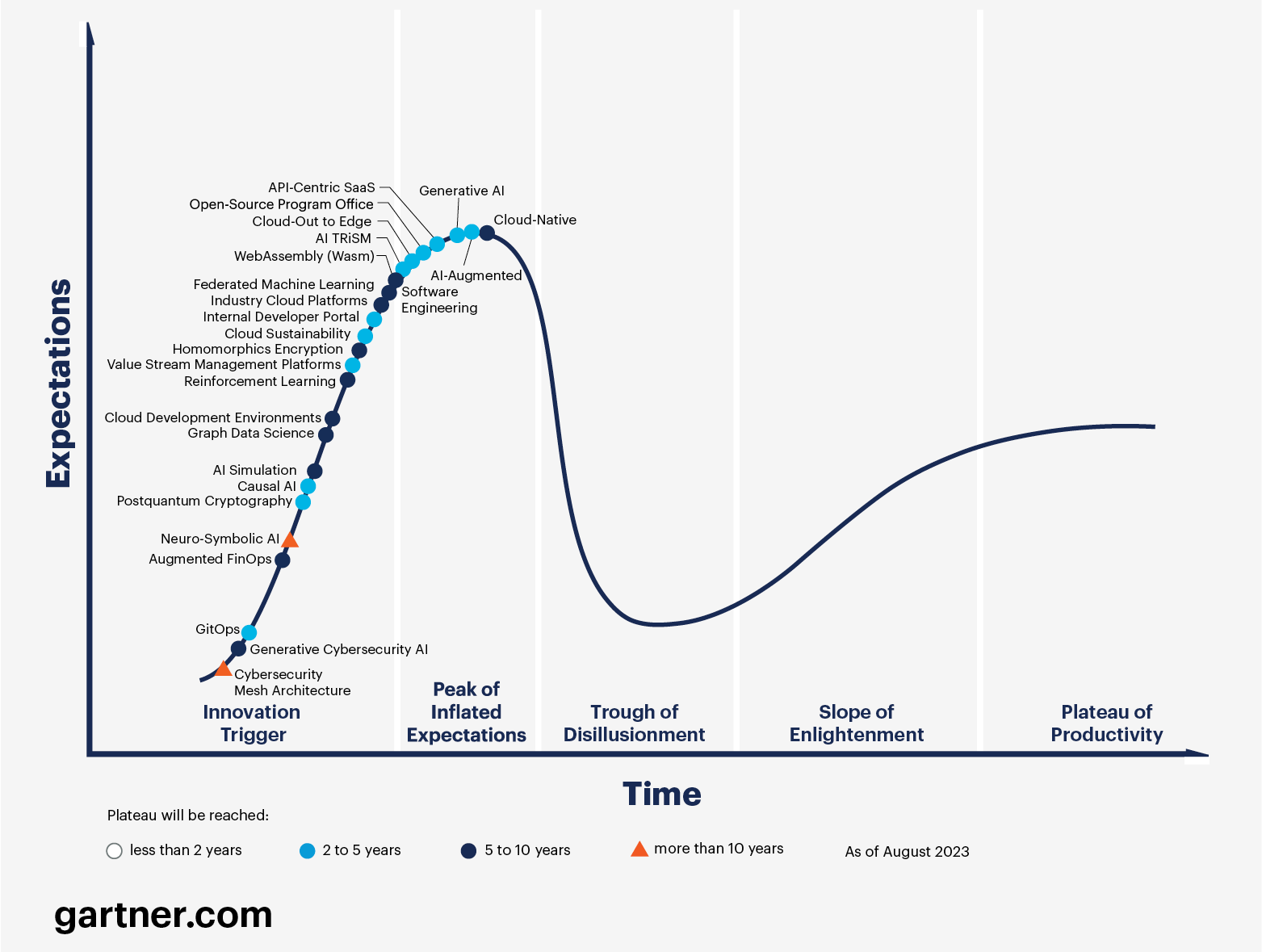Many people are expressing uncertainty regarding how emerging technologies will develop in the short term. Take generative artificial intelligence (Gen AI) as an example. By almost any measure, Gen AI invaded the legal technology scene like nothing we’ve seen in recent years. Unfortunately, the Gen AI fire spread so quickly that now, with the smoke beginning to clear, many in the legal space are wondering where it goes from here.
Understanding Gen AI’s Trajectory
According to Gartner’s 2023 Hype Cycle for Emerging Technologies, it appears that Gen AI is headed for a slowdown. That’s not unusual—many new technologies have a meteoric rise, then a slowdown, and then a more measured reemergence into the mainstream.
Gartner’s emerging hype cycle examines technologies that are expected to have great impact on business and society—in other words, technologies that will “deliver on the promise of digital business transformation.” As illustrated in the graphic below, Gartner is suggesting that Gen AI has peaked.
Gartner Hype Cycle for Emerging Technologies (2023)

Evaluating Impact Beyond Disruption
Because emerging technologies are by their very nature disruptive, it does not make sense to look only at the degree of disruption, the popularity, or even the ingenuity or innovative use of an emerging technology. Rather, it is essential to examine the specific existing and future workflows and use cases to fully understand the impact of a new technology.
One of the problems with Gen AI is that it has been over-hyped from the outset. That may be because the largest technology companies in the world raced to bring it to market to gain competitive advantage, or it could just be the shiny new object, as we’ve seen before.
In the last year, software companies have been incorporating Gen AI into their tools and platforms. If you were on-site at the recent Legalweek Conference in New York City, you could not walk ten feet without seeing signs or hearing talk of new AI products. Gen AI can do this, and Gen AI can do that. Everyone is talking about it, and everyone has an opinion. Frankly, I am no different.
I’m the last one to begrudge good innovation and the advancement of technology, particularly if it makes legal professionals more productive, but from everything I’ve heard and seen in the last few months, my sense is that the hype has gone too far.
Make no mistake, all of this is good for investors and for the companies that have launched AI products, but what does the future hold for these applications, particularly as it relates to e-discovery? Context is everything and it’s important to understand the context.
Gen AI and E-Discovery: A Realistic Perspective
What the Gartner Hype Cycle tells us is that Gen AI raced up the Innovation Trigger landscape very, very quickly, thereby raising expectations that this new “solution” would solve intractable e-discovery problems. It did not and has not yet.
Next came hallucinations and accuracy, questions involving bias, and issues relating to how complete (or incomplete) the data that forms the basis of the large language models (LLM) may be. There’s also a bit of a learning curve for using Gen AI, the lack of understanding of how Gen AI and LLMs actually work, and of course their actual utility in e-discovery specifically. And then there’s the cost, too. No one talks about the cost.
The question for e-discovery professionals is: how will an application, capable of predicting the next most probable word in response to a written query or prompt for information solve any of the choke points that are evident in e-discovery?
Let’s answer that question. Let’s have that conversation. I am absolutely certain that Gen AI can be a useful tool in managing large volumes of electronic documents. But its value lies in the margins, not in the substantive and meaningful ways that lawyers and more importantly clients want or need.
The Future of Gen AI in Legal Practices
One view is that right now Gen AI does little to nothing to improve the e-discovery process. There’s nothing transformational yet. Think about it—the discovery process is intended to discover evidence supporting the legal and factual allegations on either side of a claim or investigation. How will an application that generates content from a corpus of indexed documents—even a large corpus of documents—help identify, preserve, collect, process, review or produce evidence relevant to a claim or defense in a legal matter?
Lawyers cannot work with generated evidence; they have to actually produce real evidence, authenticate it, and then establish its admissibility.
Now, that is not to say that Gen AI will not add efficiency to e-discovery processes or that it will not be able to help analyze large sets of electronic documents. In fact, one use case clearly lies in information governance. Imagine if an organization had a deep understanding of their data pre-litigation or on an ongoing basis, or that all their documents were properly classified. That would be valuable because perhaps less data would need to be collected, processed and reviewed, and that would save time and money in all downstream e-discovery activities.
Another use case might focus on summarizing an already collected set of documents, running queries on those documents to isolate the truly relevant or meaningful content, or creating a chronology of events based on the data in the model.
We already have pretty good tools for some of this, like search, machine learning, and a host of analytics tools that are adequate at identifying relevant documents. Maybe not perfect, but certainly good enough to satisfy a “reasonable” inquiry.
Conclusion
Gen AI will certainly have an impact on the productivity of e-discovery professionals. Any application that helps to understand large collections of data, summarize it, or that helps create a first draft of a document request, a deposition outline, or argument – those things are useful and will undoubtedly help lawyers and e-discovery professionals be more productive.
But we should not pretend that Gen AI is the be-all and end-all solution to the problems facing e-discovery practitioners. It just isn’t.
Gartner’s research suggests that Gen AI has reached the Peak of Inflated Expectations and that it will decline rapidly through the Trough of Disillusionment as it becomes clear that many tools may not live up to the overinflated expectations. This does not mean that Gen AI won’t provide some utility and value in the interim. It just means that we need to reset our expectations and do the hard work. Nothing worth having comes easy, and for many, Gen AI just came too easily.
The good news is that in 3 to 5 years more mature tools will exist to truly help lawyers and legal professionals and their clients solve e-discovery problems.




